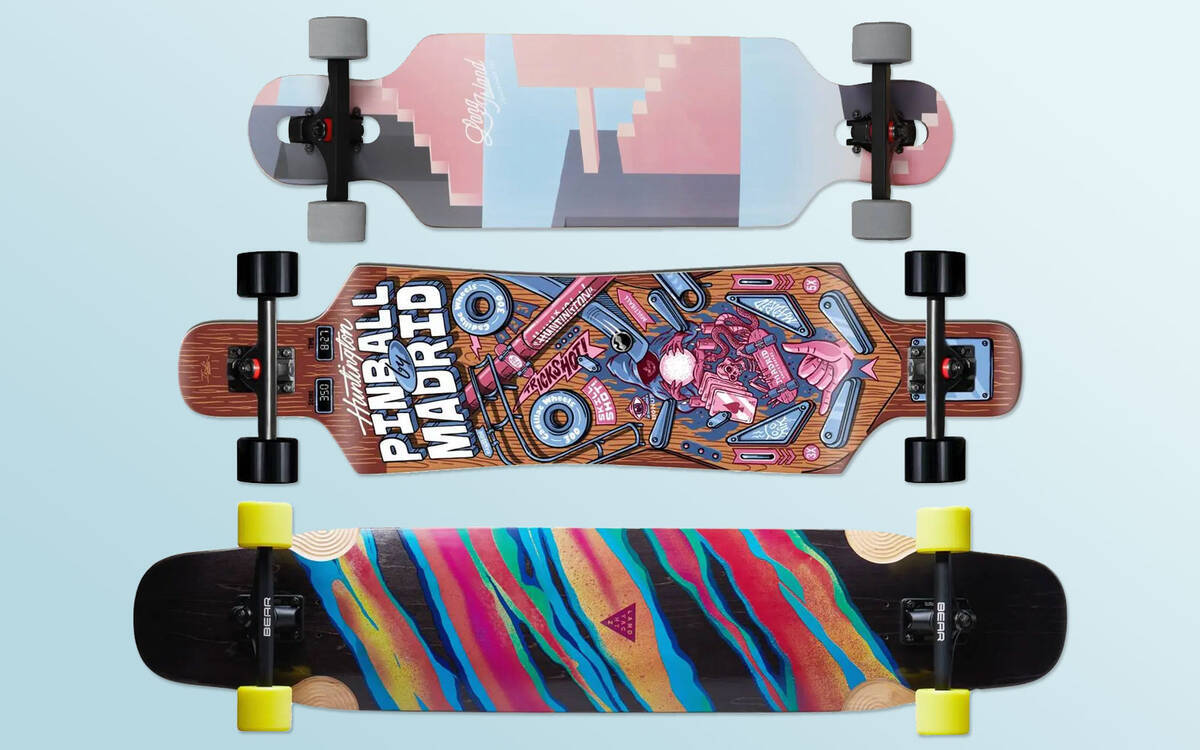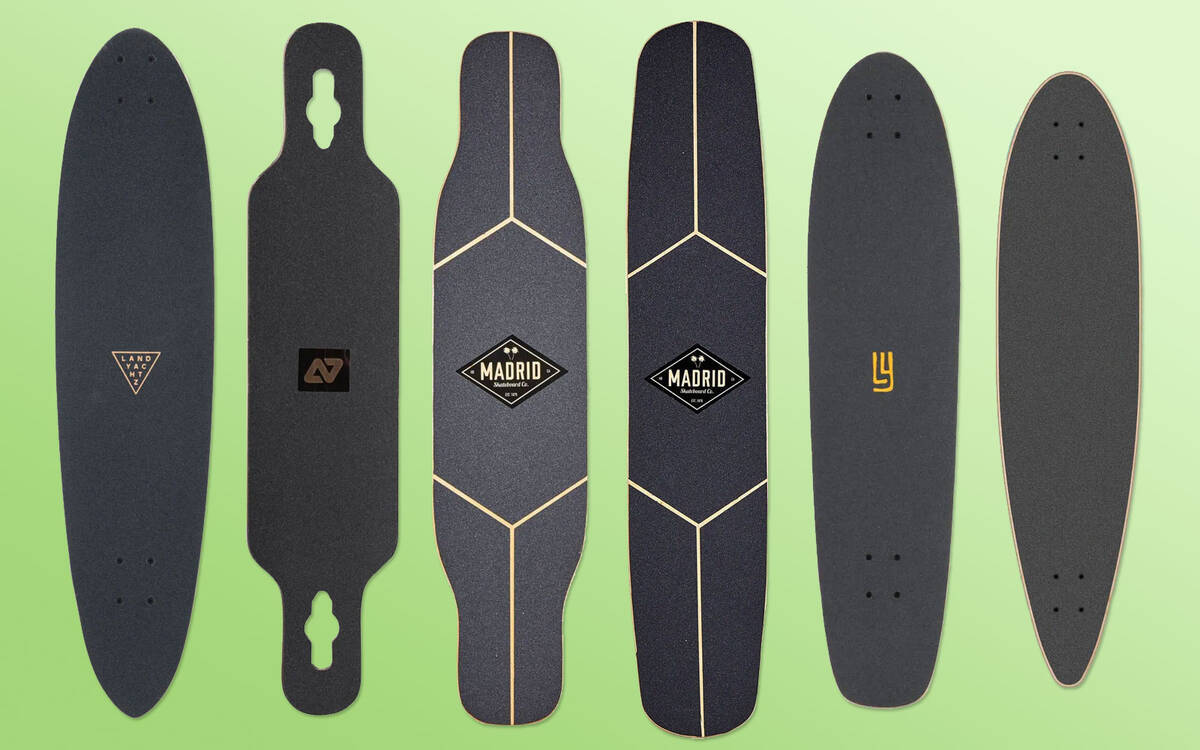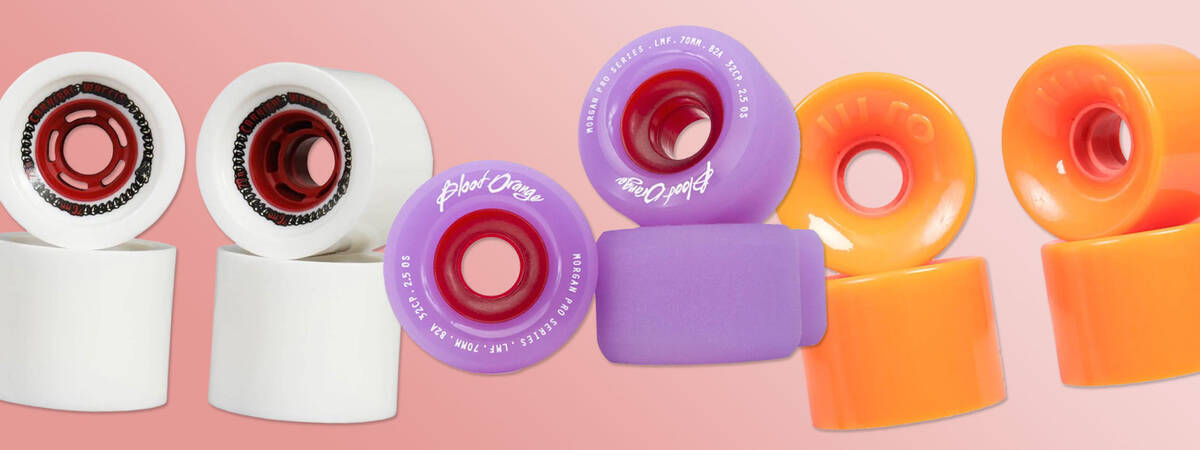Longboard Buying Guide - Selecting the Right Longboard for You
Whether you're seeking a complete longboard for a beginner, or if you're an advanced longboarder aiming to upgrade your ride and improve your experience, this guide includes all the essential information about longboards!
You don't have to go through the entire guide end-to-end (it's likely you're more interested in long boards than lengthy reads). In fact, we provide ample information on our product pages to help you choose the perfect longboard. Feel free to explore our range of complete longboards.
If certain aspects of longboarding gear catch your attention, click on the content list below to jump straight to the section that interests you the most:
Overview
Overview
Categories of Longboards - Which Longboard Should I Pick?
Different types of longboards cater to various longboarding styles. When buying a complete longboard, having a basic knowledge of longboards and longboarding disciplines can be beneficial.
If you've chosen a longboard over a skateboard, it's likely because you're seeking a smooth cruising experience or you're interested in one of the more performance-focused styles within longboarding, like longboard dancing or downhill longboarding.
The best type of longboard depends on your preferred longboarding style. In the upcoming sections, we'll delve into key aspects of various longboarding disciplines and the types of longboards linked to them. Keep reading for details on the different longboard types. We've sorted them into six categories to make it easier to choose the ideal longboard for you!
Longboard Cruisers & Carving Boards
Longboards designed for cruising and carving often share similar features. While cruising involves straightforward riding on your longboard, carving means shifting side to side to control speed, similar to how a snowboarder carves down a slope.


Cruising and carving boards share many attributes, and if you enjoy cruising, you might want to try carving occasionally. Cruiser decks usually feature pintail shapes, making them ideal for commuting or relaxed rides through the neighbourhood. Longboard cruisers emphasize stability and a smooth ride over tricks.
For beginners, cruiser longboards are an ideal option, while carving might be a subsequent step beyond cruising.
Downhill Longboards & Freeride Boards
Downhill longboards require solid stability to avoid speed wobbles, needing stiff decks and wide trucks. Optimal downhill longboards include large, wide, and soft wheels to achieve high speeds and mitigate accident risks from road inconsistencies or unexpected slides.

Curious about freeride longboards? These boards offer more versatility than their downhill counterparts, designed not just for fast downhill runs but also for technical sliding. Essentially, freeride longboards combine features from downhill boards but prioritize maneuverability, especially for sliding and carving.

Wearing protective gear is crucial for both freeride and downhill longboarding.
Freestyle Longboards
Freestyle boards are designed mainly for technical tricks and artistic lines, rather than speed. Typically, freestyle setups feature symmetrical shapes with kicks on both ends, allowing for tricks and riding either way - hence the term bi-directional. As speed and distance aren't the focus, the wheels are usually harder and smaller than those on other setups.

Embracing creativity and exploring the limits of what a longboard can achieve is the essence of freestyle longboarding. Those already passionate about skateboarding might find this style particularly appealing.
A freestyle longboard is perfect for those wanting to perform tricks while occasionally cruising as well.
Dancer Longboards
Dancer longboards are crafted for individuals who enjoy combining elegant moves and rhythm on a longboard, tailored for the artistic nature of longboard dancing, with a focus on fluid movements, intricate footwork, and expressive style.
The best longboards for dancing have symmetrical, bi-directional shapes, and are the longest available. They provide plenty of foot space for your moves and have kicks at both ends.

Dancing on a longboard requires a versatile setup, ideally featuring medium flex and responsive trucks to strike a balance between stability and agility, crucial for executing outstanding footwork.
For those fascinated by dance's rhythm and the allure of reaching new limits, a dancer longboard is the perfect partner for expressing yourself on streets and sidewalks. Embrace the vibe, liberate your creativity, and sync your moves to the beat of the pavement with the premier dancer longboard.
When you explore our complete longboards collection, you can sort them all according to riding style.
Determining the Suitable Longboard Size

The perfect longboard size is closely tied to your riding style. Unlike skateboarders, who often rely on shoe size to choose deck width, a longboarder's selection is primarily based on style rather than height or shoe size. For example, downhill setups usually have shorter decks than longboard dancing decks. Instead of solely depending on metrics, consider your riding style to find the appropriate longboard size.
Shorter longboard riders with small feet might find a smaller board more comfortable, while taller individuals with larger feet could prefer a longer version of the same type of deck. Finding the correct fit and balance for your dimensions and riding style is essential.
Wheelbase of a Longboard

The longboard wheelbase is measured between the front and back wheels. The deck's length gives a general idea of the wheelbase, but certain deck features, like kick tails, might affect overall deck length without altering the wheelbase.
A longer wheelbase means a wider turning radius, while a shorter one results in a tighter turning radius.
- Larger wheelbase: It offers a more stable configuration with slower, more manageable turns, making it easier to predict and control during slides, although it sacrifices some agility.
- Shorter wheelbase: It provides more agility at the expense of stability due to its tighter turning capability.
It's important to note that some longboard decks offer adjustable wheelbases, with eight or more mounting holes allowing for closer or farther truck placement.
Shapes of Longboard Decks

Understanding the variety in longboard deck shapes and characteristics is crucial as it will affect your deck choice. Knowing how specific shapes and features align or conflict with your style is key to making informed choices.
Pintail Longboard
Pintail decks are a common feature on cruiser longboards aiming for a surf-inspired experience. The pintail's distinct pointed design mimics the tail of pintail ducks, likely inspired by real surfboard shapes. While not ideal for freestyle, pintails offer plenty of fun to those seeking an agile board for cruising and carving the streets.
Drop Down Longboard
Drop-down decks have a lowered platform between the trucks, providing a lower centre of gravity. This reduces effort for beginners, as it eases pushing and makes steering less sensitive. Additionally, on a drop-down longboard, the extended wheelbase results from standing away from the trucks. Slide initiation is notably easier on such setups.
Drop-down decks are favoured by beginners and those who enjoy cruising, carving, or freeriding. However, for downhill speed pursuits, a deck without the drop comes recommended.
Double Drop Longboard
Double drop decks combine a lowered platform with drop-through truck mounting, leading to an extremely low centre of gravity, offering impressive stability that facilitates pushing, sliding, and balance retention at moderate speeds.
Opting for a double drop deck is beneficial if proximity to the ground is a priority, highlighting its strengths in cruising, freeriding, and sliding. Their stability makes them great for beginners and advanced riders eager for adept sliding and freeride thrills.
Wheel Wells on Longboards
Some decks come with wheel wells, concave indentations carved around the wheels to provide clearance during sharp turns or deep carves, effectively reducing the likelihood of wheel bites.
Cutouts on Longboards
Deck cutouts involve removing sections around the wheels for clearance and to prevent wheel bites. A board with cutouts entirely avoids any wood over the wheels, eliminating the risk of wheel bites.
Kicks & Double Kick Decks
Longboard kicks are raised sections at each deck end, found mainly in dancer, freestyle, and trick-centric boards, enabling moves like ollies, manuals, and kickturns, expanding the rider's repertoire. Double kick decks are crucial for dancer and freestyle setups.
Drop-Through Longboards
Drop-through longboards have their trucks mounted through the deck, lowering the ride height and centre of gravity, which enhances stability, eases pushing and sliding, and reduces fatigue over long distances. Drop-through boards are popular for freeriding, cruising, commuting, and carving.
These decks feature holes for placing the baseplates on the top side of the deck. To install trucks on a drop-through deck, the hanger must be disassembled from the baseplate.
Select true Reverse Kingpin (RKP) Longboard Trucks for drop-through setups instead of standard street skateboard trucks, ensuring peak performance.
Drop Through vs. Top Mount


Recognizing the differences between top mount and drop-through setups is pivotal, as they considerably affect your ride experience.
Attaching the trucks directly beneath the deck, positioning the deck over the trucks, is known as top-mounting. This arrangement is ideal for carving, freestyle, and ensures maximum manoeuvrability due to its enhanced leverage and responsiveness.
Conversely, drop-through mounting involves aligning the trucks through the deck's openings, positioning them lower than the deck's surface. This results in a lower centre of gravity, thereby improving stability and simplifying pushing since the pushing foot remains closer to the ground. It also aids in facilitating sliding.
Drop-through longboards incorporate cutouts near the wheels to secure wheel clearance, crucial given the deck’s lower stance. These cutouts prevent wheel bites and contribute to smoother turns by allowing the wheels to align seamlessly with the deck's underside.
Choosing between drop-through and top-mount setups ultimately depends on your preferred riding style. If prioritized stability and speed appeal to you, then a drop-through deck would be favourable. However, for those who prefer manoeuvrability and responsiveness, selecting a top-mount deck would be advisable.
To recognize drop-through decks among our longboard selections, inspect for significant openings where the trucks are affixed.
Features of Longboard Trucks

The most suitable longboard trucks for you align closely with your riding style. The trucks' various features play a vital role in shaping your setup's attributes. Key specifications to evaluate in longboard trucks include kingpin direction, baseplate angle, and hanger width.
Reverse Kingpin vs Traditional Kingpin Trucks
Frequently, you'll encounter the acronyms RKP and TKP, pointing out the distinct differences in kingpin placements on longboard trucks. Here's a quick breakdown:
- Reverse kingpin trucks (RKP) are often simply called longboard trucks, serving efficiently across various longboarding roles. The kingpin in RKP trucks points away from the setup’s center, providing stability while allowing nimble and fluid maneuvers. They are generally taller than traditional kingpin (TKP) trucks.
- Traditional kingpin trucks (TKP), sometimes known as classic or vertical kingpin trucks, are mainly designed for skateboarding, with minimal longboarding use. With a design placing the kingpin lower than the hanger, TKP trucks are particularly effective for grinding.
The decision between RKP and TKP trucks pertains primarily to their turning characteristics. Reverse kingpin trucks are praised for their reliable control at higher speeds, often regarded as more "predictable" when making high-velocity turns contrasted with traditional kingpin trucks.
Angle of the Baseplate on Longboard Trucks

The baseplate angle on longboard trucks represents the degree between a line parallel to the baseplate and a line following the pivot cup toward the hanger.
This baseplate angle significantly shapes your longboard's overall character:
- Lower baseplate angle: Results in a larger turning radius, meaning trucks need more deck lean to initiate a turn, fostering stability and minimizing high-speed wobbling. To boost your setup’s stability, choosing a lower baseplate angle is ideal.
- Higher baseplate angle: Facilitates a swifter truck with a smaller turning radius, allowing more pronounced turns effortlessly. For beginners learning the basics of pushing and turning, a steeper baseplate angle is generally beneficial.
Finding a suitable baseplate angle among our longboard trucks selection is simplified through our filtering options.
Longboard Bushings

Longboard bushings, crafted from polyurethane, are doughnut-shaped parts situated inside the truck's hanger, crucial for impacting the board's reactivity and stability. Available in several shapes, sizes, and durometers (hardness levels), they offer riders the ability to tailor the feel and performance of their board.
The hardness of bushings affects turning and stability:
- Softer bushings: Promote increased turning and carving.
- Tougher bushings: Offer better stability at higher velocities.
Different bushing shapes influence performance:
- Cone bushings: These are short and long, celebrated for their responsiveness, ideal for cruising and carving setups.
- Barrel bushings: Provide stability, making turns less eager.
- Eliminator bushings: Minimize any undesired truck movement. They are perfect for high-speed stability or those needing additional support from bushings. Their shape fills entirely around the bushing seat and exceeds the bushings' top edges, allowing softer bushings to maintain control at speeds.
Switching bushings can considerably transform the setup's dynamics. It's essential to consider them when refining your setup's features.
Dimensions of Longboard Trucks
The trucks' width should ideally align with the deck's broadest section. Excess protrusion can lead to complications like wheel interference during pushes.
To accurately configure truck width for a longboard deck, prioritize axle width over hanger width, as axle width dictates the trucks' overall width. At SkatePro, we facilitate easy identification by listing the specifications, including axle width.
- Narrow trucks: Enhance responsiveness and agility.
- Broad trucks: Deliver enhanced control and stability at speed.
All longboard truck-related components, such as parts, risers, bushings, and more, are available:
Understanding Longboard Wheels

For many, securing the right longboard wheels is paramount. These wheels can decisively shape your setup's riding traits, also available in a wide variety of colours and captivating designs, often igniting a kind of commodity fetishism among longboarding fans.
Let’s delve into the significant aspects and understand how the specifications shape your riding experience.
Longboard wheels are typically constructed from polyurethane, a flexible plastic with various forms. Manufacturers utilize unique formulas to design longboard wheels and other skate-specific wheels, crafting characteristics meant to heighten the riding experience.
When choosing longboard wheels, the key factors to keep in mind include wheel size, hardness, and shape.
Sizes of Longboard Wheels
In selecting the right wheel size, you should realize how it affects speed, momentum, ride smoothness, and manoeuvrability:
Speed and momentum:
- Larger wheels: Offer higher maximum speeds and better speed retention.
- Smaller wheels: Provide lower maximum speeds but quicker acceleration.
Smoothness of ride:
- Larger wheels: Offer a soft ride due to ample surface to absorb irregularities.
- Smaller wheels: Encounter terrain irregularities more abruptly, increasing the chances of halting over obstacles.
Maneuverability:
- Larger wheels: Offer less just maneuverability but boost stability.
- Smaller wheels: Enhance agility and facilitate easier maneuverability.
Weight:
- Larger wheels: Are generally heavier than smaller alternatives.
Sliding tendencies:
- Larger wheels: Require more effort to slide and can be challenging to control while sliding.
- Smaller wheels: Facilitate easier slides with enhanced control.
To ascertain the right size for your longboard wheels, these considerations are essential. Ensure your entire setup complements your chosen wheel size, especially focusing on avoiding wheel bites. If worried, perhaps consider risers:
Hardness of Longboard Wheels
The durometer scale, measuring hardness, is also used for all skate wheels. A higher rating indicates a harder wheel. Given the importance of wheel hardness, always examine the durometer rating, whether purchasing new wheels or a complete longboard featuring pre-selected wheels.
Key differences between hard and soft wheels include:
- Harder longboard wheels: Possess lesser grip, slide more easily, and absorb vibrations less efficiently.
- Softer longboard wheels: Offer enhanced grip, impeded sliding, and better vibration absorption.
Typically ranging from 78A to 85A, longboard wheels are notably softer than usual skateboard wheels, vital for navigating rough surfaces at considerable speeds.
Width and Shape of Longboard Wheels
The contact patch, the section making contact with the ground while riding, is determined by the wheel’s width and shape.
- Wider contact patch: Provides more grip.
- Narrower contact patch: Ensures easier slides and less grip.
Edges or lips, integral to wheel shapes, play a role in grip and slide properties. Sharp edges afford a broad contact patch, unlike those with smoother edges.
- Wheels sporting sharp edges have broader contacts, promoting grip and stability during rapid rides.
- Those with rounded or beveled edges exhibit narrower contacts, easing slides and promoting agility.
Selecting Optimal Longboard Wheels
Evaluating size, hardness, and shape collectively aids one in selecting apt wheels. However, practical tests often differ from theoretical predictions, leading to continuous experimentation with wheel choices throughout your longboarding journey.
Here are commonly asked questions regarding particular longboard wheels:
What Wheels are Most Suited for Longboard Sliding?
To excel in longboard sliding, choose smaller wheels on the firmer end of the durometer scale (up to around 85A), ideally featuring a narrow contact patch with beveled or rounded edges.
How to Decide on the Best Longboard Wheels for Cruising?
When cruising, focus on wheels that roll smoothly while efficiently handling vibrations from rough terrains. Choose softer wheels in the range of 74A to 78A that are relatively large, between 65 to 70 mm. For those prioritizing maximum grip, opt for wheels featuring sharp edges; if you prefer improved agility and a smoother ride, look for models with rounded or bevelled lips. These will serve as the ideal wheels for cruising or commuting.
Selecting Ideal Longboard Wheels for Dance and Freestyle
For dance and trick execution, prioritize lightweight wheels that offer easy control. In the realm of longboard dancing and freestyle, agility and manoeuvrability are more important than speed and stability. Choose wheels with a diameter near 65 mm and rounded or bevelled edges, along with a soft durometer rating.
